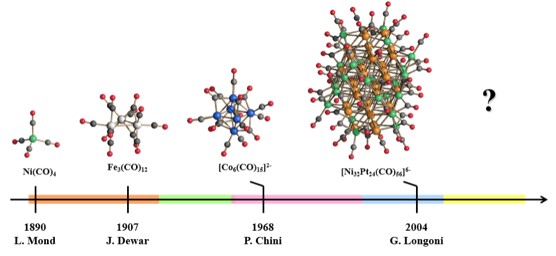Metal carbonyl nanocluster (MCC) and higher-nuclearity molecular clusters may be viewed as perfectly monodisperse and atomically defined metal nanoparticles. The chemistry of ultrasmall metal nanoparticles overlaps with that of ligand-protected molecular metal clusters. Indeed, the largest clusters studied so far already have nanometric dimensions, as in the case of the smallest metal nanoparticles.
All the knowledge, experimental techniques and methods developed along the years for the preparation, purification and characterisation of large molecular metal clusters may play a major role in a better understanding of ultrasmall metal nanoparticles and metal nanoparticles. For instance, useful information on small metal nanoparticle can be obtain by studying the electronic, spectroscopic, magnetic, structural and chemical properties of molecular cluster and, among these, higher-nuclearity MCCs. In particular, it is interesting to understand how the physical properties of metal aggregates change with increasing size, and how the transition from molecular behaviour to that of extended solid phases occurs.
Much work needs to be devoted to the preparation and characterization of increasingly larger MCCs with different compositions. Our research group has recently demonstrated that the structure of molecular MCCs with size of 1-2 nm is still strongly influenced by surface ligands and that their metallic core is extremely deformable. These findings were also confirmed in the case of Au nanoclusters, of which three different structures have recently been reported in the literature by different research groups.
The electrochemical behaviour of higher-nuclearity MCCs agrees with the incipient metallization of their metal core as the size increases. In addition, the complete understanding of the NMR and magnetic behaviour of these clusters is still one of our main goals.
Molecular MCCs can be assembled into molecular wires, charge-transfer materials and nanostructured mono-layers. Further applications in the field of nanostructured molecular materials can arise from a systematic study of their self-assembly properties.
Furthermore, Molecular MCCs can also be useful precursors for the preparation of metal nanoparticles, metal nanowires conductors (“printable metals”) and heterogeneous catalysts.
Overall, molecular MCCs can find applications as single molecular metal nanoparticles with controlled physical properties, such as supramolecular aggregates in the field of molecular materials, and as precursors of metal nanoparticles.
In conclusion, molecular metal clusters can have a substantial impact in nanosciences and nanotechnologies by contributing to a better understanding of the physical and chemical phenomena occurring in the "nanoworld". Indeed, the most promising and fascinating aspects of molecular MCCs is their borderline nature between molecular chemistry and nanochemistry.
Within this theoretical framework, the research activity of the group is focused on the synthesis and characterization of higher-nuclearity molecular MCCs, the study of their physical properties (e.g. spectroscopic, magnetic and electrochemical), to their use as building-block in self-assembly phenomena and as precursors of metal nanoparticles, metal wires and nanostructured materials. We mainly investigate clusters with metals of groups 8-10 including both homo-metallic and bi- and hetero-metallic species.
ERC sectors
PE5_6 - New materials: oxides, alloys, composite, organic-inorganic hybrid, nanoparticles
PE5_9 - Coordination chemistry
PE5_13 - Homogeneous catalysis
PE5_18 - Molecular chemistry
Scientific Coordinator
Prof. Stefano Zacchini
Members of the group
Prof.ssa Cristina Femoni
Prof.ssa Maria Carmela Iapalucci
Dott. ssa Cristiana Cesari (Researcher RTDb)
Francesca Forti (Ph.D)
Giorgia Scorzoni (Ph.D)
National and International collaborations:
- Dipartimento di Chimica e Chimica Industriale, Università di Pisa
- Dipartimento di Scienze Molecolari e Nanosistemi, Università Ca' Foscari Venezia
- Dipartimento di Fisica, Università di Parma
- Institut des Sciences et Ingénierie Chimiques, Ecole Polytechnique Fédérale de Lausanne, Switzerland
- Department of Chemistry, Catalysis Research Centre, Technical University Munich (TUM), Germany
